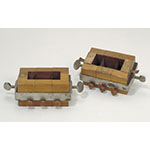These two instruments consists of three varnished wooden compartments, separated by two thin brass sheets and clamped together by means of a rectangular iron frame with a butterfly screw at each end. Each compartment has a hole in the side closed by a hardwood plug. One of the units has copper sheets bent into and over the walls of the two external compartments and two contact strips projecting above the butterfly screws. Leopoldo Nobili called these cells strettoi because of their narrowness. The compartments were separated by thin sheets of metal, such as brass, and could be filled with various solutions to study, for example, the flow of current through different substances. Replacing the metal sheets with organic membranes, Nobili studied phenomena pertaining to the decomposition of the electrolytes. Provenance: Lorraine collections.










